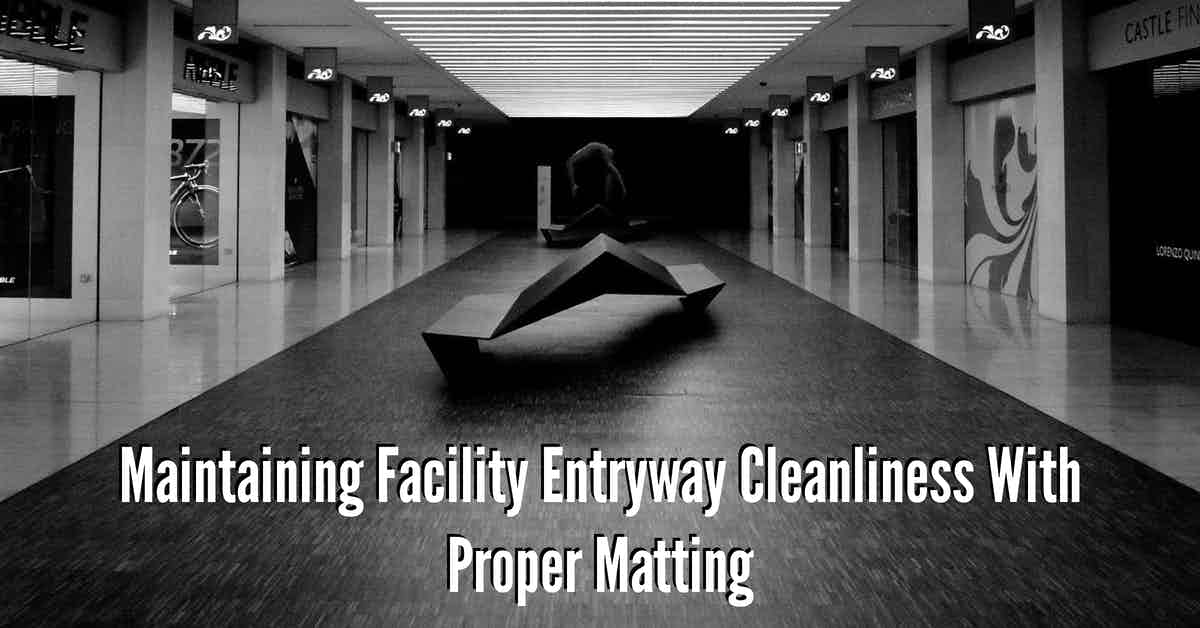Entryway matting helps maintain the professional image of the facility, protects the built environment from wear and tear, protects occupants from slips, trips, and fall accidents, and reduces the amount of soil tracked into the facility, resulting in lower overall cleaning costs.

Proper Entryway Matting Protects Facilities and Occupants
A tremendous volume of soil, germs, and bacteria are tracked into facilities every day on the bottom of occupant shoes, resulting in higher ownership costs due to cleaning and maintenance requirements.
- 100 grams (1/4 pound) per day per 1,000 people can be tracked into a commercial building during dry weather conditions, and twelve times as much dirt is tracked in during wet weather conditions.
- Up to 24 pounds of dirt can be tracked in by just 1,000 people coming through an entrance over a 20-day work period.
- Studies show that one square yard of commercial-grade carpeting can accumulate one pound of dirt over a one-week period, and up to twice as much during inclement weather.
- The estimated cost of removing a single pound of dirt from a modern building can exceed $600.
- 39% of all custodial time is devoted to floor care maintenance.
- A dollar spent keeping soil out of a building will save 10 dollars in removing the soil once it’s inside.
Source:
Further, slips, trips, and falls, which commonly occur in facility entryways due to, among other factors, poor housekeeping procedures, and poor walking or working surfaces resulting from slippery conditions--commonly the result of water on the floor either brought in from the outside on occupant shoes or from a spill or leak indoors--cost U.S. businesses billions of dollars per year in lost productivity, legal and insurance costs, and medical expenses.
According to Business Industry Connection Magazine;
The total cost burden to businesses for workplace injuries and illnesses was nearly $60 billion in 2014, according to the Liberty Mutual Workplace Safety Index.
Slips and trips (without fall) and falls (same level) accounted for over $11 billion of that total or almost 20 percent.
Adding to this cost is the fact an employee suffering from a slip, trip, or fall incident misses an average of 38 work days, costing millions of dollars to organizations in lost productivity while also driving up insurance costs.
Considering the average cost for a slip, trip or fall injury is $20,000, while the cost to defend a slip or fall claim is $50,000, it makes sense companies need to ensure they have appropriate safety practices and programs in place to address and prevent these injuries.
Properly designed, installed, and maintained entryway and walkway matting protects the built environment by catching nearly 100% of soil on the bottom of shoes and protects facility occupants by ensuring a dry, non-slip surface across potentially hazardous facility lobbies and entryways.
Steps to Protect Facility Occupants and the Built Environment
When considering facility and occupant protection with high-performance matting solutions, there are several factors to consider.
-
- Length is critical - It is estimated that 30% of the soil on shoes is trapped in the first three feet of a walkway mat, 85% in the first 15 feet, and a matting solution of 30 feet can capture 100% of soil if it is well maintained.
- Matting zones are the key to success - It is highly recommended your matting solution be divided into three distinct zones. The first--outside your main entrance--should be highly absorbent, non-slip, and aggressively scrape the bottom of occupant shoes. Zone two--the entryway--should provide a combination of scraping material and fibers to clean and dry shoes. Zone three should cover the lobby and facilitate shoe drying and particle absorbing qualities while enhancing the facility's public and professional image.
- Conduct preventative maintenance - Mats will need to be vacuumed every day and inspected for wear and tear, which are potential slip, trip, and fall hazards. Additionally, deepwater extraction services once per month on the outside will help remove trapped dirt and germs and remove stains. Eventually, mats will need to be swapped out and professionally serviced.
- Maintain good housekeeping - Regular clutter removal and cleaning outside of the facility will help protect facility occupants, prevent soil from entering the building, and ensure a high level of curb appeal.
References & Resources
- Proper Matting Keeps Entryways Clean
- How to Eliminate Slips, Trips, and Falls in Your Facility
- Protect Your Patients and Floors With Entrance Matting
- How to Prevent Slips, Trips, and Falls at Your Facility
Takeaway
High-performance facility entry and walkway matting protects the building from physical damage and wear and tear, helps prevent expensive slip, trip, and fall accidents, and removes a significant source of contamination before it is brought into the building, resulting in better occupant health and reduced cleaning and maintenance costs.
Routine matting maintenance and high-quality facility housekeeping are required to ensure optimal outcomes, which can be cost-prohibitive for many businesses.
Outsourcing to an experienced provider is a proven method for onboarding critical housekeeping and preventative maintenance services as part of a greater facility cleaning subscription service at a fraction of the cost of maintaining a similar service in-house.
Contact us today and discover why Vanguard Cleaning Systems® is the Standard of Clean® for businesses throughout Northwest Arkansas, Missouri, and Oklahoma.
In Oklahoma, dial 918-960-4450
In Arkansas, dial 479-717-2410
In Missouri, dial 417-812-9777
